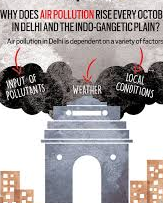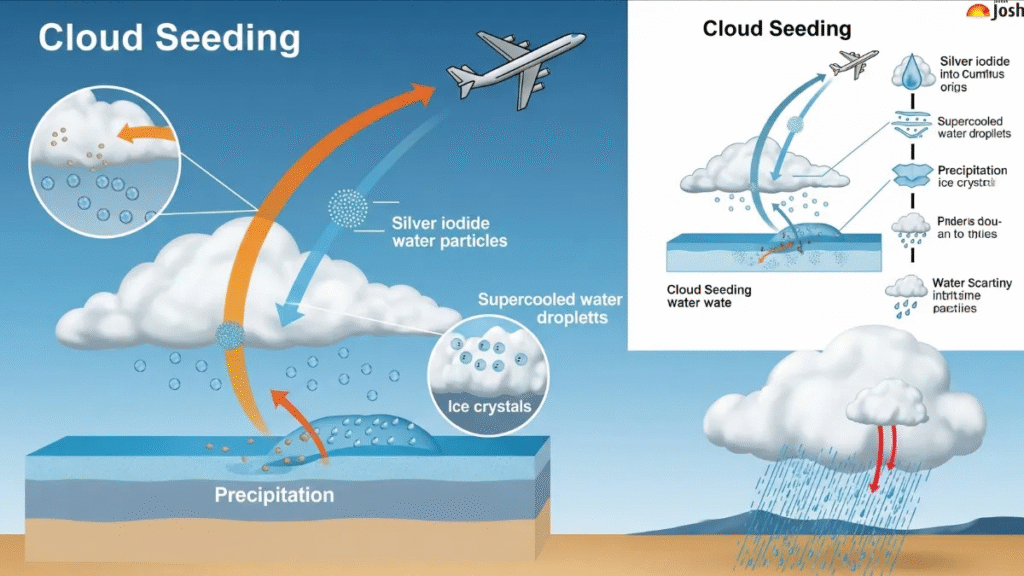In the heart of India’s capital, where the air often hangs heavy with smog and particulate matter, a groundbreaking initiative is taking shape. Delhi, a city long plagued by hazardous air quality, is gearing up for its first-ever experiment with artificial rain through cloud seeding—a bold, innovative attempt to wash away the pollution choking its skies. As the city braces for this scientific leap, questions swirl about its feasibility, environmental impact, and potential to reshape Delhi’s fight against air pollution.
The Air Pollution Crisis in Delhi

Delhi’s air pollution crisis is no secret. Each year, as winter approaches, the city’s air quality index (AQI) frequently soars to “severe” levels, driven by a toxic mix of vehicular emissions, industrial output, construction dust, and crop burning in neighboring states. The situation often worsens in October and November, when stagnant weather traps pollutants, creating a thick blanket of smog that reduces visibility and poses serious health risks. Respiratory ailments, heart conditions, and premature deaths linked to air pollution have become grim realities for Delhi’s 20 million residents.
Traditional measures—such as vehicle restrictions, construction bans, and public awareness campaigns—have yielded limited success. The Delhi government, under pressure to deliver tangible solutions, has turned to an unconventional approach: inducing artificial rain to cleanse the atmosphere. This ambitious project, set to roll out with trials in 2025, marks a significant pivot in the city’s environmental strategy.
What is Cloud Seeding?
Cloud seeding is a weather modification technique that involves dispersing substances into clouds to encourage precipitation. Typically, chemicals like silver iodide, calcium chloride, or dry ice are released into the atmosphere, either from aircraft or ground-based generators. These substances act as nuclei around which water droplets or ice crystals form, increasing the likelihood of rain or snow.
The science behind cloud seeding is not new—it has been used globally for decades, from drought-stricken regions in the United States to agricultural hubs in China. In India, states like Karnataka and Tamil Nadu have experimented with it to boost rainfall during dry spells. However, using cloud seeding to combat air pollution, as Delhi plans to do, is a relatively uncharted application in the Indian context.

Delhi’s Cloud Seeding Plan
The Delhi government’s decision to pursue cloud seeding comes after years of deliberation and mounting public pressure to address the pollution crisis. The initiative is being led by the Indian Institute of Technology (IIT) Kanpur, in collaboration with the India Meteorological Department (IMD) and other scientific organizations. The plan involves conducting small-scale trials to assess the technique’s efficacy in reducing airborne pollutants, with a potential full-scale rollout during peak pollution months if successful.
The process will involve deploying aircraft equipped with cloud-seeding chemicals to target moisture-laden clouds over Delhi. By inducing rainfall, the government hopes to wash away particulate matter, including PM2.5 and PM10, which are among the most harmful pollutants due to their ability to penetrate deep into the lungs. The trials, initially planned for the monsoon season or shortly after, aim to capitalize on periods when cloud cover is sufficient for seeding to be effective.
The Science and the Stakes
The science of cloud seeding is promising but complex. For the technique to work, specific atmospheric conditions—such as adequate humidity and the presence of suitable clouds—are essential. Delhi’s climate, particularly during the post-monsoon and winter months, may pose challenges, as cloud cover can be sparse during peak pollution periods. IIT Kanpur’s role includes conducting detailed weather modeling and water sampling to ensure the process is both safe and effective.
The stakes are high. If successful, artificial rain could offer a temporary reprieve from Delhi’s smog, improving air quality and providing relief to millions of residents. Proponents argue that even a modest reduction in pollutant levels could have significant public health benefits, potentially reducing hospital admissions for respiratory and cardiovascular issues. Moreover, the initiative could serve as a model for other polluted cities in India and beyond.
However, cloud seeding is not a silver bullet. Critics point out that it addresses only the symptoms of pollution, not its root causes, such as vehicular emissions or agricultural burning. Additionally, the technique’s effectiveness in reducing pollution remains unproven at scale. Past experiments in other countries have shown mixed results, with some studies suggesting that rainfall may not significantly disperse certain pollutants, particularly ultrafine particles.
Environmental and Ethical Concerns
The environmental implications of cloud seeding are another point of contention. The use of chemicals like silver iodide, while considered safe in small quantities, raises questions about long-term ecological impacts. Could repeated seeding affect soil, water bodies, or local ecosystems? The Delhi government has assured that rigorous scientific analysis will precede any large-scale application, with water samples tested to ensure no harmful residues enter the environment.
Ethical concerns also loom large. Artificially inducing rain in one region could potentially alter weather patterns elsewhere, possibly depriving neighboring areas of much-needed rainfall. In a country like India, where agriculture depends heavily on monsoon rains, such interventions must be carefully calibrated to avoid unintended consequences. The government has promised close coordination with the IMD to mitigate these risks, but public skepticism persists.
A Political and Public Tightrope
The cloud seeding initiative is not just a scientific endeavor—it’s a political one. Delhi’s government, led by Chief Minister Rekha Gupta, has framed the project as a bold step toward a cleaner, healthier capital. However, the move has drawn mixed reactions. Some residents and environmentalists applaud the innovative approach, while others question its cost and efficacy, arguing that funds might be better spent on long-term solutions like improving public transport or enforcing stricter emission norms.
Public perception will play a critical role in the project’s success. Delhiites, weary of years of smog-filled winters, are eager for solutions but wary of grandiose promises. The government’s ability to deliver measurable results during the trials will determine whether cloud seeding gains traction as a viable tool in the city’s anti-pollution arsenal.
Looking Ahead
As Delhi prepares for its first artificial rain trials, the initiative represents both hope and uncertainty. If successful, it could mark a turning point in how urban India tackles air pollution, offering a novel tool to complement existing measures. Yet, the challenges—scientific, environmental, and logistical—are significant. The government must navigate these hurdles while maintaining transparency and public trust.
Beyond Delhi, the experiment has broader implications. Cities like Kanpur, Lucknow, and Patna, which also grapple with severe air pollution, will be watching closely. A successful trial could spur similar efforts across the country, potentially reshaping India’s approach to environmental management.
For now, Delhi’s skies remain a battleground, caught between human ambition and nature’s limits. As the city gears up to seed its clouds, the world will be watching to see if rain on demand can indeed clear the air—or if it’s merely a drop in the bucket of a much larger fight.
Also read: Ramayana (2026): India’s Epic Reimagined on the Big Screen
Last Updated on: Friday, July 4, 2025 3:07 pm by Swayam Sharma | Published by: Swayam Sharma on Friday, July 4, 2025 2:46 pm | News Categories: News, Education, Trending
